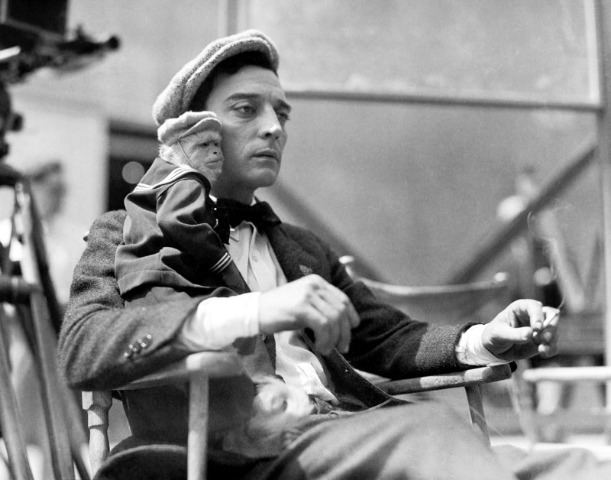The Cameraman: Man with a Movie Camera

Buster Keaton’s last great film, The Cameraman (1928), is his love letter to the machine that makes movies possible. He plays a humble street photographer who is smitten with a pretty secretary and follows her back to the newsreel office where she works. There, with catlike curiosity, he inspects a movie camera, trying the crank and the latch of the film chamber, fingers itching to delve into the mysteries of its shutters and sprockets. The girl, played by the lovely Marceline Day, is a prize he dreams of winning, but the camera—like the locomotive in Keaton’s masterpiece, The General (1926), or the ocean liner in The Navigator (1924)—is his real costar, at once an ornery antagonist and an alter ego.
In this scene, Keaton reenacts a turning point in his own life. In 1917, he had been a twenty-one-year-old vaudeville veteran who had never set foot on a film set when comedian Roscoe “Fatty” Arbuckle invited him to visit Colony Studios on East Forty-Eighth Street in New York and play a scene in the short comedy he was shooting, The Butcher Boy. Keaton later recalled that the first thing he wanted to do when he got to the studio was to “tear that camera to pieces.” Drawn to all things mechanical, he felt a burning need to know exactly how the film strip traveled through the machine, how the operator controlled the speed, what happened in the cutting room, how the film was assembled and projected. He and the movies had been born the same year, 1895, and from this first encounter he saw where his future lay; he tore up a lucrative theater contract, took a job with Arbuckle’s company, and never looked back. It helped that the camera adored him too. As soon as he stepped in front of the lens, his lucid movements and Swiss-watch comic timing, his astounding athleticism and the subtle expressiveness of his beautiful face, made him a natural creature of cinema. Arbuckle, who became Keaton’s mentor and best friend, said his protégé “lived in the camera.” He took to moviemaking with a single-minded passion, pouring himself into his films the way fuel becomes flame, leaving nothing behind except light.
In The Cameraman, Buster rushes to a pawnshop and trades in his tintype camera for an old, beat-up, hand-cranked Pathé; slinging the tripod over his shoulder and turning his cap back to front like the pros, he takes to the streets filming everything in sight. The results are inadvertently avant-garde: double exposures, tilted angles, shots running backward. Crafting these neophyte mistakes was obviously a lark for Keaton, whose actual technical mastery gave him the same seemingly effortless control over images that he had over his acrobatic body. But The Cameraman, the first film he made at MGM, was the last time he would enjoy any real control or autonomy as an artist. Since 1920, he had lived a filmmaker’s dream, with his own independent studio, Buster Keaton Productions, dedicated crew of gag writers and technicians, and almost complete creative freedom, granted by his producer, Joseph Schenck. These conditions allowed him to make movies in his own image: his performances and his films have the same mixture of restraint and wild invention; the same clean, functional elegance; the same sublime understatement. The idyll ended in 1928, when, after several features in a row lost money, Schenck shut the studio and sold his contract to Metro-Goldwyn-Mayer. Devastated, Keaton went along with the move reluctantly, and would always call it the worst mistake of his life.
Predictably, after the liberty he’d enjoyed—to improvise without a written script, to obey only the dictates of his own vision and his rigorous perfectionism—Keaton felt stymied at MGM. There were “too many cooks,” he complained, meddling and foisting bad material on him, as well as an unwieldy bureaucracy in which “you had to requisition a toothpick in triplicate.” The studio heads ballyhooed their popular new star but failed to comprehend his singular brand of comedy, and with the coming of sound they pushed him into a noisy, hectic style loaded with groan-worthy puns and strained wordplay that he despised. Not only did they misjudge his comic style, they also misunderstood his screen character: because he was short and didn’t smile, they saw him as a sad clown, a pathetic shrimp; because his comedy was physical, not verbal, they pegged him as a thick-witted dope. (Ironically, during these same years, MGM’s renowned still photographers—George Hurrell, Clarence Sinclair Bull, and Ruth Harriet Louise—churned out glamorous portraits immortalizing his dark, sculpted handsomeness and brooding mystery.)

“Keaton had an unerring instinct for how to capture each scene in the most effective, economical, and humorous way, with beauty as a by-product.”

“Working freely in silence one final time, Keaton creates in The Cameraman what James Agee called ‘beauties of comic motion.’ ”






